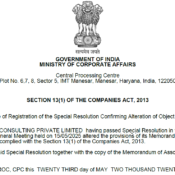What is the Procedure for Registration Under GST
What is the Procedure for Registration Under GST – Goods and Service Tax (GST) has revolutionized the Indian tax system. It was launched in 2017, to bring transparency and simplify the tax systems. If you are a businessman with turnover exceeding the threshold limit of Rs.40 lakh you may be required to register for GST. It is a unified tax system that replaced multiple indirect taxes imposed by central and state governments. This blog post is prepared by Prakasha & Co to help you learn about
The Ministry of Finance (MoF) has simplified the GST registration procedure to ease tax filing. It has become important to become aware of the procedure for registration under GST. Read this blog further to learn more about the GST, its importance, and the procedure for registration under GST.
Table of Contents
ToggleA Comprehensive Overview of GST and its Working
GST or Goods and Service Tax is a unified tax system in India. It simplifies the taxes is highly beneficial in avoiding double taxation, and helps the economy grow. The tax system applies to both goods and services and is divided into CGST, SGST, and IGST components. GST has made the Indian tax system easier to understand and has a positive impact on the country.
As per the GST laws, the tax is applied to the value added at every stage of the supply chain. GST is an indirect tax that is based on the consumption. The GST is applicable in the following mentioned stages:
- Purchasing of raw materials
- Manufacturing or production
- Storing the finished products in a warehouse
- Sale of product to wholesalers
- Sale of the product to retailers
- Sale of the product to consumers
An Overview of GST Rates in India
The GST rate is different for different services and is decided by the GST Council’s recommendations. Some items and services are excluded from the GST or taxed at a lesser rate. Fresh fruits and vegetables, milk, curd, and educational services, for example, are excluded from GST. To ensure compliance with the tax rules, taxpayers should stay up to date on any changes to the GST rates. The GST rates on different goods and services are demonstrated in the table below:
|
GST Rate |
Examples of Goods and Services |
| 5% | Necessities (edible oil, tea, coffee), certain services (travel, rail tickets, economy-class plane tickets) |
| 12% | Computers and computer peripherals, frozen meat products, animal fat, non-AC hotels, business class air tickets, telecommunications services |
| 18% | Commodities costing more than Rs. 1,000 (cement, capital goods, footwear), AC hotels serving spirits, IT services, telephone services |
| 28% | Luxury goods and services (high-end cars, yachts, private planes), tobacco, aerated drinks |
Documents Required for the GST Registration
GST registration cannot be completed without proper documentation. If you get puzzled by the document submission or other formalities of the GST registration you can always hire GST registration consultants to guide you throughout the process and simplify it for you. The list of documents required for GST registration in India are mentioned as follows:
- Company PAN card.
- The Ministry of Corporate Affairs incorporation certificate.
- Memorandum/ articles of association.
- Signatory appointment proof.
- Signatory PAN card.
- Signatory Aadhaar card.
- PAN card of all directors.
- Address proof of all directors.
Procedure For Registration Under GST
To obtain GST registration a company or business has to apply a form GST REG-01 at the GST common portal with the required details and documents for GST Registration. The entire process of GST registration is online and there is no requirement for the submission of physical documents to the GST department. Follow the steps given below to get your GST registration done in time.
Step – 1 Application at GST Common Portal
The process begins by submitting the Permanent Account Number, mobile number, e-mail address, and place of registration in Part A of Form GST REG-01 at the GST common portal. All these IDs shall be verified by the respected authorities.
The successful verification of PAN, Phone Number, and Email can be confirmed through a Temporary Reference Number (TRN) that is generated and shared with the client via mobile number or email address.
Step – 2 Submission of Documents at GST Common Portal
All the mandatory documents are required to be submitted by an application in Part B of Form GST REG-01 with required documents at the common portal duly signed and verified with Digital Signature. It is done with the Temporary Reference Number (TRN).
Step – 3 Acknowledgement of Application
On receiving the application an acknowledgement is issued electronically to the applicant in Form GST REG-02.
Step – 4 Final Verification of the Application and Approval
The applications and all the submitted documents are examined by the concerned officer within three days of submission. If all the documents are approved the registration is granted to the applicant. In case there is an anomaly found in the application or the documents submitted, a notice is issued to the applicant, electronically in FORM GST REG-03.
Step – 5 Issue of GST Registration Certificate
The authorities will issue the GST certificate with a unique GSTIN (GST Identification Number) after your application has been approved. This number is required on all invoices and is used for all GST-related transactions.
Conclusion
GST registration has become a crucial aspect of running a business smoothly. However, you should remember that the registration process may vary for different states and it is important to complete all the formalities with the guidance of the best GST registration consultants. Another way to simplify GST registration is by reaching out to the experts at Prakasha & Co and escape the complexities of GST registration in your state.
Like Us On Facebook

Our Client's Review
EXCELLENTTrustindex verifies that the original source of the review is Google. Best place to file ur GST n IT returns .. They respond quickly, communicate well and get ur work done as per ur needs in a very short time ..Posted onTrustindex verifies that the original source of the review is Google. Best place for Income tax filingPosted onTrustindex verifies that the original source of the review is Google. Of all the CA, CS teams I have interacted with, they are the most prompt and organized. I have taken their services for almost 3 years now for various things like income tax queries, income tax filing, networth certificates, and compliance certificates. They always display a clear understanding of the law and are also able to explain it to you in layman terms. Overall a very resourceful and courteous team. Thank you for the support!Posted onTrustindex verifies that the original source of the review is Google. Best company secretary I bangalore ever seen such quick quality servicePosted onTrustindex verifies that the original source of the review is Google. Prakasha & Co has been a lifesaver for me when it comes to my tax dispute and filings with IT office. They are always very responsive and helpful whenever I have any questions or issues, I recently had an issue with my sister business GST filings, and they were able to quickly identify the issue and help me resolve it. They really go above and beyond to make sure their clients are taken care of.Posted onTrustindex verifies that the original source of the review is Google. ''The team at Prakasha& Co made sure my company was compliant with all the legal requirements. Their attention to detail and timely response was truly remarkable."Posted onTrustindex verifies that the original source of the review is Google. "I was impressed with the level of customer service provided by Prakasha& Co. They were always available to answer my questions and provide guidance throughout the company registration process."
Important Links
- Top 10 GST Registration Consultants in Bangalore
- Top 10 Best Income Tax Lawyers in Bangalore
- Top 10 Trademark Registration Consultants in Bangalore
- GST Registration in Bangalore
- Private Limited Company Registration in Bangalore
- Partnership Firm Registration in Bangalore
- Proprietorship Registration in Bangalore
- Trademark Registration in Bangalore
- Audit Frim in Bangalore
- CA Firm in Bangalore
- Accounting Services in Bangalore
- GST Lawyers in Bangalore
- Payroll Services Provider in Bangalore
- Payroll Consultant in Bangalore
- Income Tax Lawyer in Bangalore
All Categories
- Audit
- Blogs
- Bookkeeping Services
- Company Registration
- Company secretary Legal & Chartered Accountant
- Digital Signature Certificate (DSC) Services
- FSSAI Registration and Consultation
- GST
- Income tax
- Partnership Firm Registration
- Payroll Services
- Risk Management Services
- Startup Registration Process
- Trademark Registration
- Uncategorized








